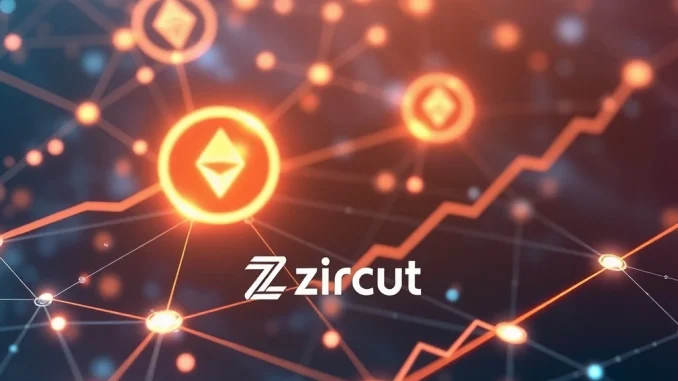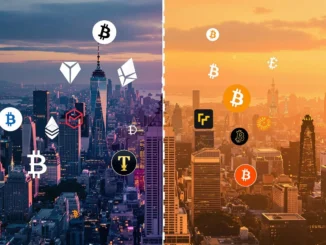
The world of decentralized finance (DeFi) is a whirlwind of innovation, constantly pushing the boundaries of what’s possible in financial markets. Yet, for all its promise, DeFi has grappled with persistent challenges: fragmentation across various blockchains, execution latency, and, critically, security vulnerabilities. Imagine a world where these hurdles are significantly diminished, where trading across different chains is not just seamless but also intelligently optimized and safeguarded. This vision is now closer to reality, thanks to Zircuit. This blockchain security-focused platform has just unveiled its groundbreaking Hyperliquid AI Engine, a development poised to revolutionize the way we interact with Cross-Chain DeFi. The market’s excitement is palpable, with the native ZRC token experiencing a remarkable 50% surge immediately following the announcement. Let’s dive deep into what makes this new AI Trading Engine a game-changer.
Unveiling the Hyperliquid AI Engine: What Makes It Revolutionary?
At its core, Zircuit’s Hyperliquid AI Engine is designed to be the brain behind lightning-fast, secure, and intelligent cross-chain transactions. It’s not just another bridge or a simple trading bot; it’s a sophisticated system engineered to streamline real-time trading strategies across the often-fragmented landscape of blockchain networks. The engine boasts broad compatibility, supporting both Ethereum Virtual Machine (EVM) compatible chains – which encompass a vast ecosystem of DeFi protocols – and Solana, a high-throughput blockchain known for its speed. This dual-chain support is crucial, as it allows for a truly interoperable DeFi experience, something users have long clamored for.
The launch of this AI Trading Engine builds upon Zircuit’s already impressive track record. The platform’s Deposit Vaults have successfully safeguarded over $950 million in assets, including stablecoins, ETH, and BTC, demonstrating a strong foundation of trust and security. With the Hyperliquid AI Engine, Zircuit introduces a suite of cutting-edge features that promise to elevate the DeFi trading experience:
- Automated Signal Detection: Leveraging advanced AI algorithms, the engine meticulously analyzes vast amounts of on-chain and off-chain data. This isn’t just about price feeds; it includes liquidity patterns, network congestion, news sentiment, and even social media trends. The goal is to identify optimal trading opportunities that human traders might miss or react to too slowly.
- Cross-Chain Auto-Routing: One of the biggest headaches in DeFi is moving assets and executing trades across different blockchains. The Hyperliquid AI Engine simplifies this with intelligent auto-routing. It identifies the most efficient and cost-effective paths for transactions, ensuring seamless execution whether you’re moving from Ethereum to Solana or between various EVM chains.
- One-Click Strategy Execution: For traders, setting up and executing complex strategies can be daunting. Zircuit aims to abstract away this complexity. Users will be able to initiate sophisticated trading strategies with just a single click, relying on the AI to manage the underlying intricacies of execution, liquidity sourcing, and slippage minimization.
- Zircuit-Grade Security: This is perhaps the most critical component. Zircuit understands that speed and intelligence are meaningless without robust security. The Hyperliquid AI Engine is underpinned by “Zircuit-Grade Security,” a comprehensive framework that includes sequencer-level security (SLS) and anti-phishing measures. SLS is particularly innovative; it’s engineered to prevent exploit vectors by ensuring transaction integrity during cross-chain execution, a historical weak point for many interoperability protocols. This proactive approach to security aligns perfectly with the growing regulatory scrutiny in the DeFi space, where vulnerabilities have often led to significant financial losses.
Dr. Martin Derka, Zircuit’s co-founder, succinctly articulated the platform’s overarching mission: to “make on-chain finance both safer and smarter.” This ambition is realized through the powerful synergy of real-time AI insights combined with seamless, secure execution.
Transforming Cross-Chain DeFi: Addressing Fragmentation and Latency
The current state of Cross-Chain DeFi is often likened to a fragmented archipelago – many islands of liquidity, each with its own rules, assets, and user base. Moving between these islands can be slow, expensive, and risky. Zircuit’s new AI Trading Engine directly addresses these pain points. By enabling lightning-fast execution and intelligent routing across disparate networks, it aims to unify the DeFi landscape, making it more efficient and accessible for everyone from retail traders to institutional players.
The integration of AI algorithms for analyzing on-chain and off-chain data is a significant differentiator. Traditional DeFi trading often relies on manual monitoring and reactive strategies. Zircuit’s AI, however, can proactively identify trading opportunities, arbitrage possibilities, and even potential market inefficiencies by crunching vast datasets in real-time. This level of algorithmic decision-making has long been a cornerstone of high-frequency trading in traditional finance, and its robust integration into DeFi infrastructure represents a maturation of the space.
However, the journey to truly unified and secure cross-chain operations is not without its challenges. The engine’s success hinges on its ability to maintain consistent, high-level security and performance across both EVM and Solana ecosystems, which, despite their growing interoperability, still possess distinct technical architectures, smart contract languages, and governance models. Zircuit’s emphasis on “institutional-grade security” could indeed set a new benchmark for cross-chain solutions, provided it demonstrates unwavering performance even under high-stress market conditions and adapts swiftly to evolving blockchain standards.
The ZRC Token Surge: A Vote of Confidence and Future Incentives
The market’s immediate and enthusiastic response to the launch of the Hyperliquid AI Engine was unmistakably clear: the native ZRC token soared by an impressive 50% in value post-announcement. This significant price movement is a powerful indicator of investor confidence, reflecting a strong belief in Zircuit’s vision and its capacity to automate and secure complex cross-chain operations. Analysts are buzzing, attributing the surge to the perceived value of an AI-powered solution that promises to solve critical pain points in DeFi.
Beyond the initial market reaction, Zircuit has laid out a compelling roadmap for the Hyperliquid AI Engine, focusing heavily on community engagement and incentivization:
- Phased Rollout for Controlled Growth: The rollout will commence with a closed beta in late July 2025, an exclusive opportunity for existing Deposit Vault users. This controlled environment will allow Zircuit to fine-tune the engine based on real-world feedback before a broader release. The public launch is slated for August 2025, at which point SDK access will be provided, empowering strategy developers to build on top of the Zircuit platform.
- Massive Ecosystem Grants: A truly exciting development for the developer community is the allocation of 10 million ZRC tokens by Q4 2025. These tokens will fund ecosystem grants, specifically designed to support community-built AI models. This initiative is a clear signal of Zircuit’s commitment to fostering a vibrant, collaborative ecosystem where innovation is rewarded.
- Attractive User Incentives: To encourage early adoption and participation, users in the beta phase will receive trading incentives. Furthermore, new participants in Zircuit’s Deposit Vaults will enjoy fee rebates on their future AI trading activities, creating a strong incentive to join the ecosystem.
- AI-Trading Competition: For developers eager to showcase their skills, an upcoming AI-trading competition offers substantial grants and rewards for innovative strategies built using the Hyperliquid AI Engine. This competitive environment is expected to spur rapid development and discovery of new use cases.
These incentives are strategically designed to cultivate a robust and engaged community, which is crucial for the long-term success and adoption of any decentralized protocol.
The Future Landscape: How Zircuit’s AI Trading Engine Positions Itself
The introduction of Zircuit’s AI Trading Engine arrives at a pivotal moment in the cryptocurrency market. With heightened volatility and a burgeoning speculative interest in AI-driven financial tools, Zircuit is uniquely positioned to capitalize on the current DeFi innovation cycle. The platform’s emphasis on institutional-grade security is particularly noteworthy. As DeFi continues to mature, attracting larger institutional capital will be paramount, and these entities demand the highest levels of security and compliance.
The competitive landscape in DeFi is fierce, with numerous layer-2 solutions and cross-chain bridges already vying for market share. Zircuit’s deep integration of AI into its core infrastructure could force these competitors to accelerate their own AI integrations to remain relevant. The shift toward algorithmic decision-making, previously a hallmark of traditional finance, is now firmly establishing itself in the decentralized world. This trend suggests a future where DeFi operations are not only faster and more efficient but also more intelligently optimized.
Long-term adoption, however, will extend beyond initial hype. It will critically depend on sustained institutional participation, the platform’s ability to consistently demonstrate performance under diverse market conditions, and its adaptability to evolving blockchain standards and regulatory frameworks. If Zircuit can maintain its security posture, foster a thriving developer community, and continue to innovate, its Hyperliquid AI Engine could indeed become a cornerstone of the next generation of DeFi.
Conclusion: A New Era for Cross-Chain DeFi?
Zircuit’s launch of the Hyperliquid AI Engine is more than just a new product; it represents a bold step towards a more intelligent, secure, and seamlessly interconnected decentralized financial future. By merging cutting-edge AI capabilities with an unwavering commitment to security, Zircuit is not merely enhancing trading efficiency; it is actively building a safer and more robust foundation for the entire DeFi ecosystem. The impressive 50% surge of the ZRC token serves as a powerful testament to the market’s confidence in this transformative vision.
As Zircuit meticulously rolls out its new engine and actively cultivates a vibrant community through strategic incentives, it stands poised to usher in a new era of intelligent, secure, and truly seamless cross-chain operations. This innovation has the potential to reshape how we perceive and interact with digital asset trading, making it more accessible, efficient, and ultimately, more reliable for users worldwide. The journey of the Hyperliquid AI Engine has just begun, and its impact on the future of DeFi will be keenly watched.
Frequently Asked Questions (FAQs)
What is the Zircuit Hyperliquid AI Engine?
The Zircuit Hyperliquid AI Engine is an advanced, AI-powered trading engine designed to facilitate lightning-fast, highly secure cross-chain transactions within the decentralized finance (DeFi) ecosystem. It supports both Ethereum Virtual Machine (EVM) compatible chains and Solana, offering features like automated signal detection, cross-chain auto-routing, and one-click strategy execution to optimize trading.
How does Zircuit ensure security for cross-chain transactions?
Zircuit employs a robust security framework called “Zircuit-Grade Security.” This includes innovative Sequencer Level Security (SLS), which is specifically engineered to prevent exploit vectors and ensure the integrity of transactions during complex cross-chain executions. Additionally, the platform integrates comprehensive anti-phishing measures to protect users and their assets, addressing common vulnerabilities in interoperability protocols.
What impact has the launch had on the ZRC token?
Following the highly anticipated announcement of the Hyperliquid AI Engine, Zircuit’s native cryptocurrency, the ZRC token, experienced a significant surge in value, climbing by an impressive 50%. This sharp increase reflects strong investor confidence and market optimism regarding the platform’s potential to automate and secure cross-chain DeFi operations, enhancing efficiency and accessibility.
When will the Hyperliquid AI Engine be publicly available?
The rollout of the Hyperliquid AI Engine is planned in phases. A closed beta for existing Deposit Vault users is scheduled for late July 2025. The broader public launch, which will include SDK (Software Development Kit) access for strategy developers, is set for August 2025, allowing a wider range of users and developers to engage with the platform.
Are there incentives for users and developers to join the Zircuit ecosystem?
Absolutely! Zircuit is offering several incentives to foster community growth. Users participating in the initial beta phase will receive exclusive trading incentives. New participants who join Zircuit’s Deposit Vaults will also benefit from fee rebates on their future AI trading activities. For developers, Zircuit plans to allocate 10 million ZRC tokens by Q4 2025 for ecosystem grants to support community-built AI models, and an AI-trading competition will offer additional grants and rewards for innovative strategies.
How does Zircuit’s AI engine aim to revolutionize DeFi compared to existing solutions?
Zircuit’s AI engine aims to revolutionize DeFi by deeply integrating algorithmic decision-making and institutional-grade security directly into cross-chain infrastructure. Unlike many existing layer-2 solutions or cross-chain bridges that primarily focus on asset transfers, Zircuit’s Hyperliquid AI Engine actively optimizes trading strategies, reduces latency, and enhances overall security through real-time AI insights. This comprehensive approach seeks to make DeFi operations more intelligent, efficient, and reliable, setting a new standard for decentralized financial tools.



